Description
FRACTAL AXE-FX III PRESET DESIGNED FOR USE WITH ACOUSTIC GUITARS
IMPORTANT NOTES
- UPDATE YOUR FIRMWARE: Please upgrade the firmware on your Axe-FX III. and make sure to use the latest version of Axe-Edit III before installing this preset. If your firmware is not up to date, this preset may not load.
- FC FUNCTIONALITY BUILT IN: This preset was built to work with the Fractal FC-12 and an external expression pedal plugged into the ‘Pedal 1’ input. See the Per-Preset overrides and FC assignments below.
SIGNAL FLOW AND EFFECTS
- Input 1 (the Input Noise Gate is turned off to save CPU).
- Vol/Pan 1
- NOTE: The ‘Volume’ parameter is NOT MAPPED. You’ll need to map this parameter to an expression pedal if you’d like to use the volume block.
- Compressor 1
- Channel A: JFET Compressor (1176 Style Comp): set to be somewhat transparent, general use comp. This is the compression setting we recommend.
- Channel B: Studio FF Compressor 1: set to be somewhat transparent, general use comp.
- Channel C: Dynamicomp (Dynacomp): Lots of compression and squish.
- Channels D: Optical Compressor (LA-2A style)
- IR Player 1
- Use this block to load acoustic impulse responses (off by default). NOTE: We do not include any acoustic IR’s with this preset, but we have a selection available at Worship Tutorials.
- Paremetric EQ 1
- Always on EQ. This is a general use EQ setting that should work well for most acoustics. It rolls off low end and adds brightness.
- Only channel A is set up.
- PanTrm 1
- Channel A : Tremolo – fixed tempo
- Channel B: Tremolo (1/4 Trip note sync)
- Channel C: Bias Trem – Bradford’s ramping trem settings (based on LFO1a)
- Channel D: Tremolo (1/16 note sync – set for a choppy trem sound)
- Chorus 1
- Channel A : Dimension 1
- Channel B: Japan CE-2
- Channel C: Analog Stereo
- Channel D: Dimension 1 (more pronounced chorus effect)
- Graphic EQ 1: ‘Brighter’
- This EQ will add highs and take away lows. It’s mapped to a button labeled ‘Brighter’. Use this with darker acoustics. Off by default
- Only channel A is set up.
- Graphic EQ 2: ‘Darker’
- This EQ will add lows and take away highs. It’s mapped to a button labeled ‘Darker’. Use this with bright/thin sounding acoustics. Off by default
- Only channel A is set up.
- Delay 1: (Quarter and 8th note delays)
- Channel A: Analog Stereo (1/4 delay with a wide stereo field)
- Channel B: Analog Stereo (1/4 delay with a wide stereo field)
- Channel C: Analog Stereo (1/8 delay with a wide stereo field)
- Channel D: Analog Stereo (1/8 delay with a wide stereo field)
- Delay 2: (All dotted eighth note delays)
- Channel A: Stereo Mind Guy
- Channel B: Vintage Digital
- Channel C: 2290 w/ Modulation
- Channel D: Stereo Tape
- Delay 3: (All dual stereo delays)
- Channel A: Stereo Mind Guy (1/8 and Dotted 8th in stereo)
- Channel B: Stereo Tape (Dotted 8th and Quater in stereo)
- Channel C: Stereo BBD (Quater and Quater Triplet in stereo)
- Channel D: Vintage Digital (Quater and Dotted 8th – huge washy delay for swells)
- Reverb 1: (‘Normal’ verbs in parallel)
- Channel A: London Plate
- Channel B: Medium Spring
- Channel C: Large Hall
- Channel D: Medium Plate
- Reverb 2: (Big ambient verbs)
- Channel A: Stratocumulus
- Channel B: Cirrocumulus
- Channel C: Deep Space
- Channel D: Nimbostratus
- Plex Delay 1: (Plex verb for huge swells and ambient reverb)
- Channel A: Plex Verb (big ambient reverb for swells)
- Channel B: Plex Verb (ambient reverb – not quite a huge as channel A)
- Channel C: Shimmer Verb (shimmer)
- Channel D: Plex Shimmer (shimmer – not as smooth as Channel C)
- Parametric EQ 2: Notch Filters
- This EQ acts as a notch filter – use it if you are experiencing feedback in a live environment.
- Channel A: Notch filter for the Low E string
- Channel B: Notch filter for the A string
- Channel C: Notch filter for the D string
- Channel D: Notch filter for the G string
- Looper
- OUT
SCENES
The following scenes are set up for instant access to various tones:
- Scene 1: DRY. Only compression and the main EQ
- Scene 2: BASIC PLATE. Plate reverb (subtle)
- Scene 3: BASIC SPRING. Spring reverb (subtle)
- Scene 4: AMBI. Lots of delay and ambient reverb
- Scene 5: RHYTHMIC DLY. Dotted 8th + 1/4 delay
- Scene 6: AMBI TREM. Ambient reverb + tremolo
- Scene 7: AMBI CHORUS Ambient reverb + chorus
- Scene 8: SWELLS. Big ambient swells
USAGE NOTES
IR PLAYER BLOCK (no IR’s included with this patch)
Acoustic Impulse Responses can make a massive difference in your direct acoustic tone. We’ve included an IR block in the patch if you’d like to use IR’s. By default the IR block is off, and no IR is loaded. You can adjust this block for basic tone shaping of your individual guitar.
EQ: PARAMETRIC EQ 1: This is meant to be an always-on EQ. It does basic tone shaping for acoustic guitar.
EQ: GRAPHIC EQ’s: These EQ block can make your overall sound brighter or darker. If your guitar sounds too dull or dark, engage the ‘Brighter’ EQ. If your tone is too bright or thin, engage the ‘Darker’ EQ.
EQ: PARAMETRIC EQ 2 (NOTCH FILTERS): This parametric EQ block on the bottom row is meant to serve as notch filters to eliminate feedback. These four EQ’s notch out frequencies on the lower four strings on acoustic. If you are experiencing feedback on the low E string, engage channel A. If you are experiencing feedback on the A string, engage channel B. If you are experiencing feedback on the D string, engage channel C. If you are experiencing feedback on the G string, engage channel D.
STEREO
This preset is in stereo. If you are running mono, you’ll want to set up Axe-FX to sum the preset to mono.
The easiest way to make this adjustment is in the ‘Setup’ menu:
- Choose ‘Setup’, and select ‘I/O’
- In OUTPUT 1 CONFIGURATION (choose the physical output you are using), change the ‘Mode’. Select ‘STEREO’ if you are running in stereo. Select ‘’SUM L+R’ if you are running mono. This will convert your output to mono and sum the stereo image. This will also cause all your presets to output in mono, as it is a global setting.
BLOCK CHANNELS
For almost all blocks, we’ve set up multiple channels to give you different options for any given effect. Feel free to experiment and find the sounds you like best. However, not all blocks have all four channels set up – some have just couple, and some only one. See the Signal Flow section above to see what is set up in what channel for any given block.
DELAYS
We’ve used all four channels of three delay blocks (that’s 12 different delays!) . Each delay block runs in parallel with the others so the delays don’t run into each other.
Delay blocks are separated into different delay times. For example, Delay 1 is all quarter or 1/8th note delays. Delay 2 is all dotted 8th noted delays, and Delay 3 is all stereo dual delays. Delay three is a bit different because each channel will give you different rhythmic delays, and Channel D is set to give you a huge wash for swells.
The delays run between the amp and cab to simulate an effects loop in an amp. This means the cabinet will filter the tone of the delays, making them a bit less clean/pristine (we prefer the way they sound this way). Feel free to move them all after the cab (but before the verbs) to experience them in a different way.
REVERB
We’ve set up reverbs the same way as delays – each reverb block contains four versions of the same type of reverb (normal and big).
Reverb blocks 1 and 2 give you ‘normal’ and ambient reverbs respectively, but the PlexDly block will also give you ambient reverbs. Experiment with these to find your favorite sounds.
PER-PRESET MAPPING AND OVERRIDES
This preset integrates with the Fractal FC-12. We’ve set up Per-Preset overrides for both effects and scenes, and we’ve mapped them to Layouts 7 (Perform 1) and 8 (Perform 2). If you have an FC-12, the following assignments should be plug-and-play. Layout 7 will be your scenes and Layout 8 will be individual effects, plus swells.
HERE ARE THE PER-PRESET MAPPINGS AND THE BUTTONS THEY’RE ASSIGNED TO OVERRIDE
PP1: Scene 1: Layout 7 Button 2
PP2: Scene 2: Layout 7 Button 3
PP3: Scene 3: Layout 7 Button 4
PP4: Scene 4: Layout 7 Button 5
PP5: Scene 5: Layout 7 Button 8
PP6: Scene 6: Layout 7 Button 9
PP7: Scene 7: Layout 7 Button 10
PP8: Scene 8: Layout 7, Button 11
PP9: Comp 1 – Not assigned
PP10: Not assigned
PP11: Reverb 1A – Plate Verb – Layout 8, Button 4
PP12: Reverb 1B – Spring Verb – Layout 8, Button 5
PP13: Reverb 2 – Cloud Verb – Layout 8, Button 6
PP14: PlexDly1 – NOT ASSIGNED
PP15: Delay 1 – Layout 8, Button 2, ‘1/4 DLY’
PP16: Delay 2 – Layout 8, Button 3, ‘1/8d DLY’
PP17: Delay 3 – Not assigned
PP18: Delay 4 – Not assigned
PP19: TremPan 1 – Layout 8, Button 10
PP20: Chorus 1 – Layout 8, Button 11
PP21: Pitch 1 – NOT ASSIGNED
PP22: Graphic EQ 1 – Brighter – Layout 8, Button 8
PP23: Graphic EQ 2 – Darker – Layout 8, Button 9
PP24: IR Player 1 – Layout 8, Button 12
MAKING CHANGES TO THESE ASSIGNMENTS
If you’d like to change any of these assignments (either the Per-Preset Assignments or the Overrides), you can do so in the ‘CONTROLLERS’ menu on the Axe FX III. Press ‘CONTROLLERS’ from the Home screen, then select ‘Per-Preset FC Settings’ and make changes.
If you would like to go back to your default settings for Layouts 7 and 8, you can reset the Overrides from the ‘Overrides’ menu in the ‘Per-Preset-FC Settings’ section.
MAKING ADJUSTMENTS FOR YOUR SETUP
SETTING THE PRESET UP FOR YOUR GUITAR
All guitars are different, so you may want to make changes to suite your playing style and guitar. To adjust the preset for your guitars, the primary controls to adjust would be:
- EQ settings (PARAMETRIC EQ1). The parametric EQ can do most of the work necessary to shape the overall tone of the preset. If your guitar sounds to bright/thin, remove highs and add low end. If it is too boomy or dark, remove low end and add highs. You can also engage the ‘Darker/Brighter’ Graphic EQ’s.
- Volume/Output level. Acoustic guitars can vary quite a bit regarding the output level of the pickup systems installed in them. Most guitars have a volume control on the preamp. You want the output of the guitar to engage the compressor but not by a large amount. Axe-FX III will show you the level of gain reduction on the compressor. You want to see between 3 and 5db of gain reduction. If you are seeing more than that, try to lower the level coming from the guitar. You can also adjust the threshold control on the compressor. From there, you can adjust the overall volume of the preset by using the output level of the compressor block, or the output level of the ‘Out’ block.
CHANGELOG
Version 1.0 (initial Release): 2020-01-13
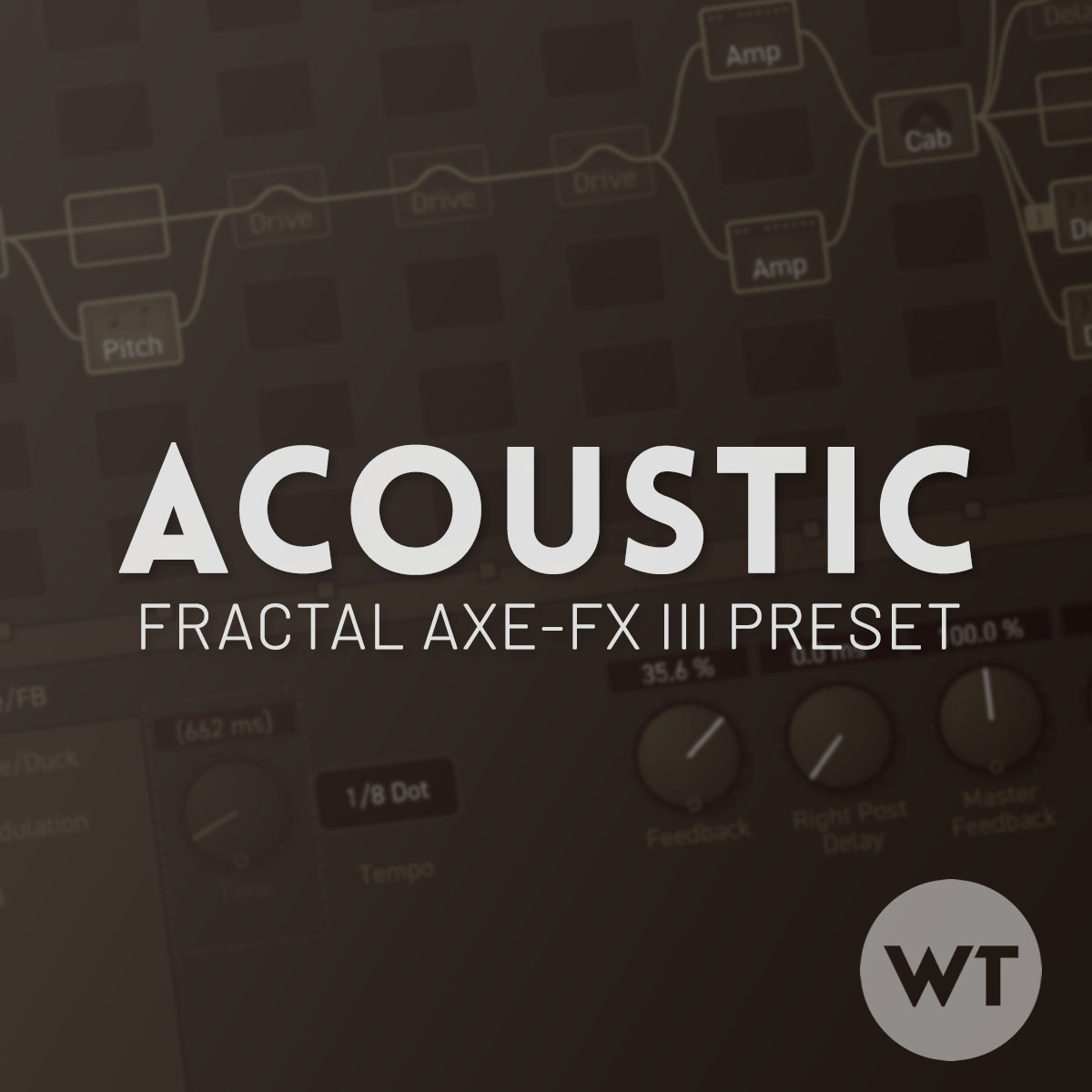
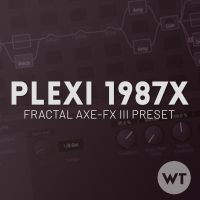
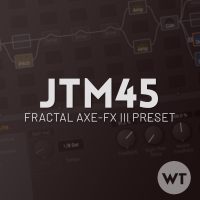
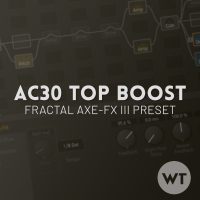

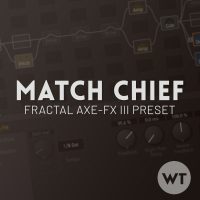

Reviews
There are no reviews yet.